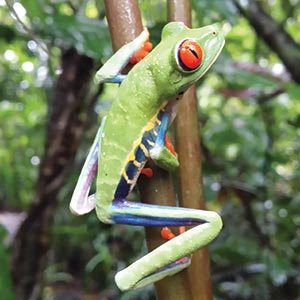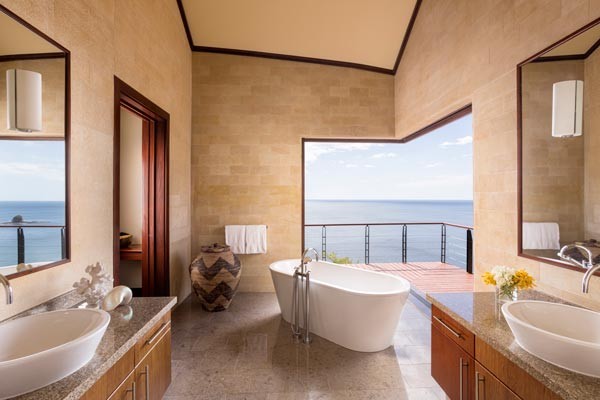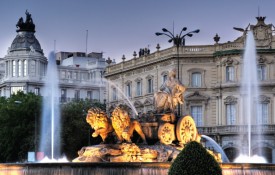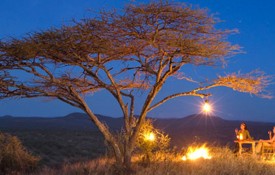
Whether surrounded by lush greenery in the flourishing rainforest, zip lining in the shade of a grand volcano, or walking along a sandy Costa Rican beach, visitors will quickly recognize why this Central American country is such a popular destination. Here you will find friendly, peaceful people in an eco-conscious environment where traditions are celebrated and living la pura vida – “the pure life” – is a state of mind and way of life. With no standing army and a gracious attitude toward visitors, this green jewel of a country offers solace, relaxation, and adventure. Those seeking to awaken every morning in a natural paradise to a lovely variety of birdsong with myriad adventures in store will not be disappointed.
Costa Rica is recognized as Central America’s eco- and adventure-tourism capital, and it truly lives up to the Spanish meaning of its name, “rich coast.” More than one quarter of the country is dedicated to national forests, often adjoining beaches, and there are tracts of untamed wilderness. In addition to housing an impressive array of exotic flora and fauna within its relatively narrow borders – the entire country is roughly the size of West Virginia – Costa Rica boasts a string of pristine beaches and more than 130 towering volcanoes. Whether tubing down river rapids, zip lining over jungle canopies, kayaking, or surfing the waves with the pros at Witch’s Rock, the adventurous will find endless opportunities for entertainment and sport in a spectacular natural setting.
Costa Ricans, also known as “Ticos,” greet visitors from all over the world via the country’s two international airports: Daniel Oduber Quirós International Airport in the city of Liberia in Guanacaste province, and Juan Santamaría International Airpot in San José, the capital city as well as the country’s largest province. It is also possible to access Costa Rica via private yacht. Upon arrival, many visitors rent or hire a car for their visit. While the bulk of the roads are well-maintained, some require 4-wheel drive such as the dirt road winding toward the famed Monteverde Cloud Forest. For the best weather, most visitors arrive during the dry season, from November to May, rather than the wet, rainy season that Costa Rica experiences during our summer and fall.

Myriad volcanoes form the northern spine of Costa Rica, fueling volcanic activity and the natural hot springs that soothe the aches of weary travelers and locals alike. Near the capital city of San José, the volcanoes Poás and Irazú are easily accessible, with paved roads to the top where visitors can tour a museum and visitor’s center. Nearby waterfalls, coffee farms, and cloud forest trails allow travelers to experience the authentic Costa Rica. At the Santa Elena and Monteverde Cloud Forest Reserves, you can walk along the bridges through the trees and watch the wildlife.
Costa Rica’s second largest province, Guanacaste, lies in the northwest and is home to national parks with diverse wildlife and numerous volcanos as well as some of the country’s best surfing beaches. Howler monkeys, iguanas, and white-nosed coati abound. Picture-perfect beaches with soft sand and shells strewn about offer a relaxing opportunity to cool off after a long day of exploration. In this province, the climate is warm and arid, ideal for sun-lovers and striking in contrast with the cooler, humid air of the country’s interior jungles.
For those seeking a posh getaway on the rugged Pacific Coast, the Four Seasons Resort Costa Rica at Peninsula Papagayo is among the most luxurious resorts in the country as well as Central America. Guests are welcomed graciously with cool scented towels and treated to excellent service in a stunning setting. Whether in the area for business or pleasure, visitors can soak in the beautiful views from well-appointed rooms and villas with elegant features and cloud-soft bedding. The tortoise-shell-shaped roofs of the villas blend into the landscape, one of the key goals when the property was built. Several fully equipped conference spaces allow for productive small- to medium-sized meetings. The Four Seasons spa offers customized therapeutic massages and signature treatments as well as a Jacuzzi with an outdoor cold plunge overlooking the ocean.

The Arnold Palmer signature 18-hole golf course, rated among the Top 100 international courses by Golf Digest, offers spectacular views of several islands dotting the rugged coastline. The adjacent Peter Burwash International Tennis Center offers clinics and lessons for all levels. Foodies will be in their element sampling the delicious locally grown and sourced dining options concocted by the skilled chef in the restaurant Caracol – housed in the architecturally striking golf course clubhouse reminiscent of the Sydney Opera House. Here you can sip an 18th on the Green, a delectable chiliguaro-based cocktail made with the popular Costa Rican liquor, and savor the sunset before taking a peek at the stars through the telescope set up on the lawn. fourseasons.com/costarica
On the Peninsula Papagayo, the site of a future Jack Nicklaus Design golf course as well as various private luxury housing clusters, is the Exclusive Resorts. Guests of the Four Seasons and Exclusive Resorts have access to Prieta Beach Club, an exclusive seaside sanctuary with a coveted west-facing beach. The full-service Marina Papagayo, Costa Rica’s first and only luxury marina, is the preferred gateway to some of the finest fishing and cruising grounds in Central America. Recognized as one of the best sportfishing locales in the world, sportfishing charters are offered by numerous companies operating out of Quepos, Herradura, and Tamarindo among other marinas.

Experience one of many national parks by joining the sabaneros on horseback on the slopes of the volcano Rincón de la Vieja or hike all 11,000 feet to the crater. Rincón de la Vieja offers lodging as well as numerous activities such as tubing in the river, zip lining in the narrow canyons over streams, and soaking in natural hot springs after brushing on therapeutic hot mud at the local hot springs.
For those interested in rafting and tubing, one of the world’s best whitewater runs can be found to the south in Turrialba, where the Río Pacuare allows rafters to take in the jungle scenery. The rain and cloud forest national parks surrounding the Turrialba, Barva, and Miravalles volcanoes are also popular for exceptional hiking, birding, and wildlife watching.
Heading east from Guanacaste toward Lake Arenal, the landscape gradually becomes more lush and green. The winding one-lane road heading toward La Fortuna is dotted with tiny clusters of shops and local restaurants where visitors can enjoy a panoramic view over the lake while dining on typical home-cooked Costa Rican fare such as gallo pinto or “spotted rooster,” a traditional breakfast with rice, beans, eggs, cheese, tortillas, and meat. Several restaurants in the area stand out for delicious but reasonable meals, including La Parrila de Maria Bonita and La Ventanita.
The spectacular lava displays during the perfectly conical Volcano Arenal’s 1968 eruption have long faded as the volcano lies relatively dormant, but they led to the area’s growth into an ecotourism mecca of spas and resorts. Despite the growth of tourism in other areas of the country, Arenal Volcano National Park is still home to the most rafting rivers, canyoneering adventures, and zip lines in Costa Rica.
Luxury spas beckon amidst the rainforest in the shade of the famous volcano such as the renowned Tabacón Gran Thermal with its waterfalls, thermal hot spring pools, and gardens. Complete with lush tropical grounds, the Arenal Nayara’s private bungalows – some with outdoor garden showers and decks complete with Jacuzzis and hammocks – draw travelers seeking relaxation and rejuvenation. The hot springs flow into a nearby river cutting through the jungle, where locals take in the water as well.
Not to be missed is the spectacular La Fortuna Waterfall, which cascades 246 feet to a large picturesque pool. Toucan sightings are common in the lush jungle area surrounding the falls, and monkeys and iguanas go about their business as visitors descend 500 steps down to the base of the falls to swim and enjoy the cool, crystal-clear water.

Also near Arenal lies the Ecocentro Danaus, an ecological reserve with accessible trails through a botanical garden, butterfly farm, and tree nursery. Offering tours and supporting environmental education programs, the reserve preserves a natural regenerating secondary grow forest with great diversity of flora and fauna in its natural ecosystem. Here visitors can see red-eyed tree frogs, sloths, snakes, iguanas, and much more.
Travelling down the Peninsula de Nicoya, Playa Grande offers beginning surfers a clement place to learn the sport, while famous Tamarindo Beach attracts surfers of all levels. Pro surfers will appreciate the waves at Witch’s Rock, accessible only by boat. South of the lively bars and restaurants of the local favorite Playa de Coco, one will discover Playa Avellanas. Here one can sit and watch the surfers while dining at the popular beachfront restaurant Lola’s, christened in honor of the resident pig. Further down the coast on the peninsula are numerous yoga resorts such as Nosara Yoga Institute, offering respite and focus to those seeking to strengthen mind and body.
San José, with its revered historical buildings and lively arts scene, is the cultural and political center of Costa Rica. The neoclassical façade of the Teatro Nacional stands in the center of the city, an architectural gem and testament to San José’s enduring commitment to the arts. Visitors searching for handcrafted treasures will likely find what they seek in San José’s Mercado Central, although bright, tropical art and local handicrafts are found in the numerous small villages and towns dotting the Costa Rican countryside as well. For example, the Central Valley’s small town of Sarchi is where curious tourists can pick up carretas, colorfully painted oxcarts that are the symbol of the Costa Rican worker.

In addition to its lovely landscape, activities, and views, Costa Rica boasts one of the world’s most biologically diverse marine ecosystems. Here you will find extensive coral reefs and protected wetlands as well as unique creatures such as the little olive ridley sea turtle with its heart-shaped shell. The Cahuita National Park protects the greatest coral reef on the Caribbean coast. Cocos Island, a Costa Rican National Park that is home only to its native rangers, was named one of the best scuba diving spots in the world by the Professional Association of Diving Instructors (PADI). Purportedly dubbed “the most beautiful island in the world” by Jacques Costeau, divers travel just over 340 miles off the coast of the province of Puntarenas to reach Cocos Island and enjoy the variety of breathtaking marine life.
This green gem awaits exploration, shining in the Central American landscape by virtue of its lush jungles, towering volcanoes, beautiful beaches, and friendly locals. The eco-conscious mindset that the country embraces makes it likely this lovely natural paradise will be preserved for generations to come, but there is no time like the present: Come experience la pura vida for yourself in Costa Rica.












































